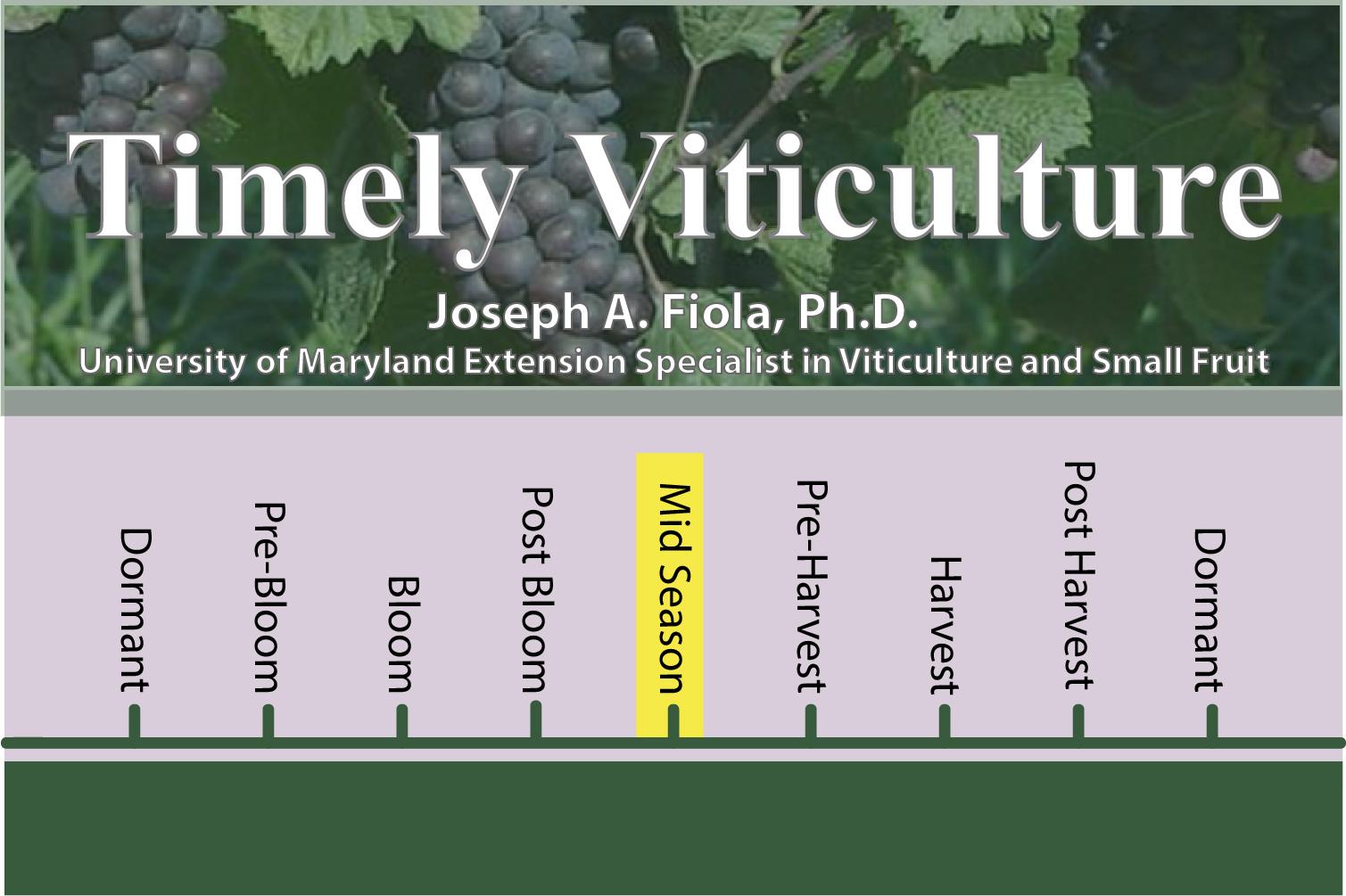Japanese Beetles
Japanese beetles can periodically be a significant pest in Maryland vineyards. They create large holes in the younger leaves of vines and cause severe lacing and even fruit damage in heavy infestations. The population build-up is typically periodic and cyclic and may require control tactics in years of large infestations. Always be extra careful with young vines as they cannot tolerate severe defoliation.
Identification and Biology

- Japanese beetles (scarab beetle family) are approx. ½ inch with metallic green bodies and copper-colored wings.
- They are voracious feeders and attack the foliage of numerous woody and ornamental species (roses are a preferred food) as well as grapevines.
- They have a very broad list of alternate species they feed on and have been known to fly for up to 5 miles.
- Adults emerge from the soil and begin moving into vineyards in late June.
- They remain present for about 2 months during which they feed, mate, and the female lays eggs in the soil.
- Japanese beetles become established in an area (in the turf) and populations rapidly build up over a couple of years.
- Once established, the chances of eradicating them from an area are slim.
Damage
- They tend to feed on younger leaves.
- In an extreme infestation without control vines can be completely defoliated.
- They tend to be more damaging during droughty seasons.
- The tolerance of younger vines is much less because total leaf area can easily be defoliated which can lead to increased winter damage and vine death.
Scout and Manage
- Scout for damage and the presence of beetles from early-late June through mid-late August.
- Because they are constantly emerging and moving into the vineyard, constant scouting and vigilance are required and control measures may be needed quickly and even frequently.
- Since they typically arrive from outside the vineyard, you can sometimes find arrival hot spots where you can target and concentrate control if needed.
- The usual threshold for making a spray application is about 15% of the leaves damaged.
- Remember that well-established vines can tolerate significant foliar feeding by Japanese beetles when it is the upper younger leaves that are above the top catch wire and about to be hedged off anyway.
Control*
- If you have a few in the vineyard, just “squish” them on the leaf. There is evidence that the dead beetles may repel others.
- The materials labeled for controlling Japanese beetles are Assail®, Actara®, Avaunt®, Belay®, Danitol®, Imidan® (14-day REI!), Neemix 4.5 plus Trilogy, and Sevin®.
- Remember that frequent, repeated sprays of Sevin® will also kill many beneficial insects (including mite predators) which can then lead to a mite outbreak. Again this is exacerbated in hot dry weather.
- Repeated applications may be needed to control new beetles flying in from surrounding areas.
- Surround® can be used to protect the foliage from feeding and has been very effective in some locations.
- Where Japanese beetle populations are low or beetles are just beginning to be seen and fewer sprays are needed, using a “softer” insecticide can reduce the risk of mite outbreaks.
- Biological control agent Bacillus popilliae (milky disease) can protect grassy areas from large larval populations, but it is ineffective against adults entering the vineyard.
- Japanese beetles also have natural predators, including wasps and flies that can parasitize larvae and adult beetles, again emphasizing the importance of avoiding insecticides that will harm beneficial's.
*Always read the pesticide label for complete information and product safety.
For further information on the biology and control of Japanese beetles, check out the following websites
- Japanese beetle, Popillia japonica Newman on Grape
Virginia Fruit Web Page, Virginia Tech
- Grape Second Cover Spray
Virginia Tech
- Managing Adult Japanese Beetles
L.H. Townsend, Extension Specialist
University of Kentuck Department of Entomology
- Japanese Beetle and Other Coleoptera Feeding on Grapevines in Eastern North America
Arthropod Management in Vineyards: PP 403-429
Douglas G. Pfeiffer, Virginia Tech
Timely Viticulture is designed to give those in the Maryland grape industry a timely reminder on procedures or topics they should be considering in the vineyard.
